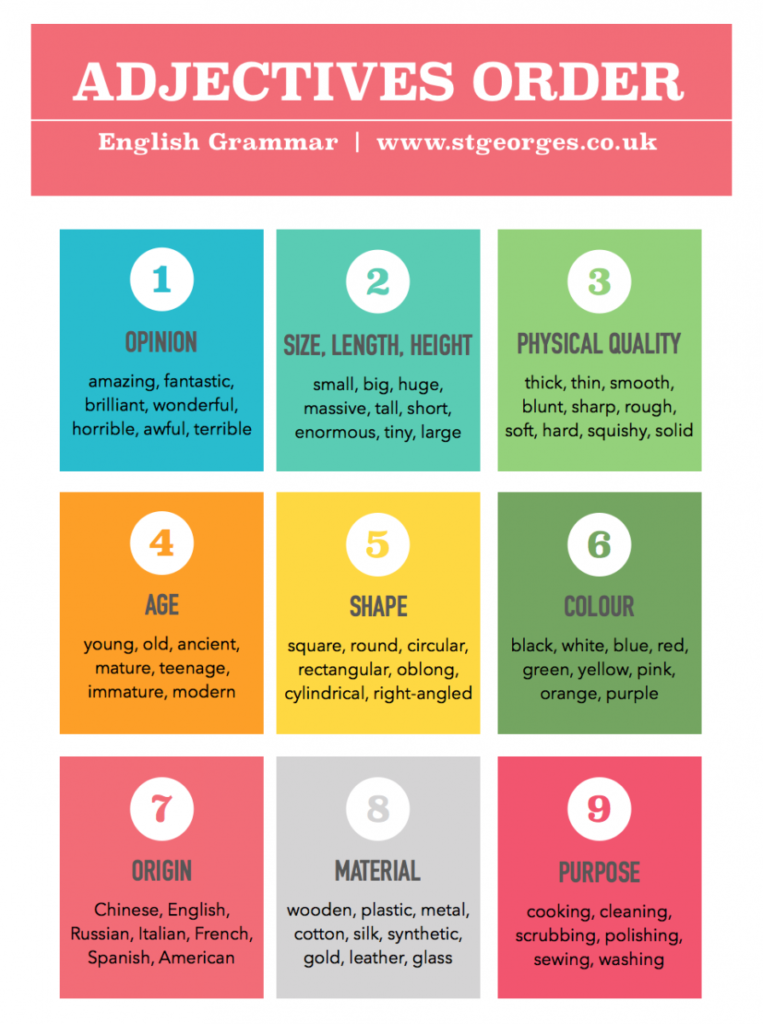When you are studying English there are sooooo many things to learn every step of the way.
English is one of the easiest languages in the world to get started with and be able to communicate with basic sentences quite quickly.
But every time that you reach a higher level and you think you have got to the top of the mountain, there is always something new aspect of the language to learn. It is then that you realise that it is really a long way to the top of the mountain until you reach advanced levels or being fluent in English.
Native speakers of English can make mistakes from time to time, but one thing that is completely natural for mother tongue speakers, but can be quite tricky for second language speakers is the order of adjectives in a sentence.
When you have more than two adjectives that are helping to describe a noun, the adjectives are said in a specific set order.
Quick Example: He played the last song with a fantastic white guitar last night.
In the above example sentence, GUITAR (noun) is described with the 2 adjectives, FANTASTIC and WHITE.
Why didn’t I say, a white fantastic guitar?
Well, for a native speaker it sounds strange/incorrect/unusual because adjectives about your opinion (fantastic) always appear first and definitely before an adjective that is a fact like a colour (white).
Let’s look at some more adjectives…. Japanese lovely pink small
About 7 years ago, I used to have a ___ ___ ___ ___ phone.
What is the correct order for the four adjectives?
Have a look at the picture below and see if you can find out the correct order for the words.

- Japanese = ORIGIN (#7 above)
- Lovely = OPINION (#1 above)
- Pink = COLOUR (#6 above)
- Small = SIZE (#2 above)
Correct sentence: About 7 years ago, I used to have a lovely small pink Japanese phone.
One more example: Adjectives to use – Young, Italian, tall
On my flight there were lots of ____ _____ _____ basketball players on the way to play in an international tournament
So, using the information in the image above, the correct sentence is –
On my flight there were lots of tall, young, Italian basketball players…
ADJECTIVES AFTER A VERB & BEFORE A NOUN
When you use 3 or more adjectives after a verb (like ‘to be), really you are creating a kind of list.
When this happens, you normally say/write AND before the last adjective
Examples:
1. Wow, it is such a beautiful, hot and sunny day outside!
2. This Presidential election campaign has been nasty, long and vindictive from the beginning.
THE SAME TYPE OF ADJECTIVES
When you use the same kind of adjectives in the same sentence, you normally use AND to separate them
Examples:
1. He wears a blue and white checked shirt to work almost every day.
*NOT He wears a blue white checked shirt….
2. They have got Irish and German parents.
*NOT They have got Irish German parents.
3. The team has a good mix of young and old players
*NOT The teams has a good mix of young old players
YOU MAY ALSO LIKE….
Adjective Alphabet – A list of adjectives that you can use in a writing task that will be marked by an SGI teacher
Adjectives vs Adverbs – Basic grammar rules for adjectives and adverbs
Better English vocabulary – An A to Z of adjectives all describing ‘great’
No Native English speaker says this: Grammar Rule of the day – How NOT to mix adjectives and adverbs
FREE ONLINE GRAMMAR TEST – Test your English knowledge with the SGI Grammar test. There are 40 grammar questions with immediate results, which gives you an idea about your current level of English.

